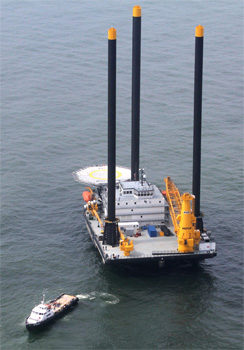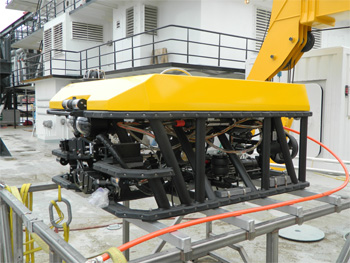A 2010 federal regulation that requires oil and gas companies to plug nearly 3,500 non-producing wells and dismantle about 650 unused production platforms in the Gulf of Mexico has not created the anticipated boom for maritime companies that specialize in this work.
“People thought it was going to be a gold rush, but there are too many barges and too many players doing it,” said Tommy Gibilterra, vice president of operations for Bisso Marine, based in Houston.
A lot of people thought there would be a spike in the market, according to Joseph Orgeron, chief technology officer for Montco Offshore Inc., based in Galliano, La. “But no, it didn’t happen.”
On Sept. 15, 2010, U.S. Secretary of the Interior Ken Salazar announced that wells, platforms or pipelines that are no longer producing or serving exploration or support functions connected with a company’s lease — are to be decommissioned.
 |
|
Montco Offshore currently gets about two-thirds of its work from decommissionings. Its newest lift boat, Robert, above, underwent sea trials in February. The company expects to hire about 20 people to work as crew. |
|
Photo courtesy Montco Offshore |
Oil wells must be plugged and platform structures dismantled within one year after the lease expires, according to the federal regulation, which took effect on Oct. 15, 2010. If any well can no longer be used for operations and cannot produce oil, gas or sulfur in paying quantities, that well must be permanently plugged or temporarily abandoned within three years from Oct. 15, 2010, or within three years of no longer being useful for operations, whichever date is later.
The decommissioning process is very complicated and includes several phases, including obtaining federal permits, creating engineering plans, preparing the platform, well plugging and abandonment (called P&A work), platform removal, materials removal, pipeline and power cable decommissioning and site clearance.
Specialized companies do the plug-and-abandonment phase of decommissioning. Lift boats are sometimes used in this process.
“We do the platform work, and also some pipeline abandonment,” said Gibilterra, “but we don’t do the P&A work on the well itself.”
The federal order has produced steady work, but the platform dismantling in many cases just replaced work that disappeared because of the recession. “It has definitely helped us,” Gibilterra said. “It is work, and we are glad to have it. But it is not an increase in work by any stretch of the imagination.”
Between October 2010 and September 2011, about 721 wells on the idle iron list were temporarily or permanently abandoned, according to Eileen P. Angelico, spokeswoman for the federal Bureau of Safety and Environmental Enforcement, which regulates offshore oil wells.
Nonetheless, Bisso is quite active in this type of work. Gibilterra said Bisso removed 50 platforms in 2011. And the company does have work contracted through the end of 2015. Bisso uses flat-bottom barges, derrick barges, crane barges, lift boats, revolving deck barges and stiff-leg barges for the platform work.
Montco Offshore has seen a rise of about 10 percent in this type of work, which now accounts for about 65 percent of its business, according to Orgeron. The company provides lift boats for decommissionings.
There were great expectations that more work would come over the short term, said John A. Witte, Jr., executive vice president at Donjon Marine, based in Hillside, N.J. “Like everyone else, we are sitting and waiting for that to come to pass,” he said. “It’s work that continues to come out on a piecemeal basis.”
Donjon does leg and platform removal, as well as lifting components off the seafloor, he said. The company uses deck barges, tugboats, support craft and barges to carry and remove platforms and components to shore for disposal.
The recession and a slower than expected pace in well decommissioning has meant that the number of jobs for mariners in this sector has not significantly increased. According to Gibilterra, many qualified workers had been employed in new construction or hurricane repairs when the recession hit. “They just kind of rolled over to do this work,” he said.
However, companies that invest in new boats or barges are hiring. In February, Montco was putting its latest lift boat, Robert, through sea trails. Orgeron said it will be the largest lift boat in the gulf.
The company is hiring for this boat, Orgeron said. Because the technology is much more complex, the company will be hiring licensed engineers at salaries approaching those of captains, he said. Montco will also need heavy lift managers, heavy lift riggers and welders. The company will likely hire an additional 20 people for this new lift boat.

